Dyskinesia Treatment Advisor
Find Your Best Alternative Treatment
Select your symptoms and preferences to receive personalized recommendations based on the latest research.
Your Personalized Treatment Recommendations
Recommendations are based on clinical evidence and should be discussed with your healthcare provider. Individual results may vary.
Living with dyskinesia can feel like a constant battle against unwanted movements. While standard medications help many, they often bring side‑effects or lose potency over time. If you’ve tried the usual drug regimen and are still searching for relief, you’re not alone-there’s a growing toolbox of alternative treatments dyskinesia patients turn to.
Understanding Dyskinesia
Dyskinesia is a movement disorder characterized by involuntary, erratic, and often repetitive motions. It most commonly emerges as a side‑effect of long‑term levodopa therapy in Parkinson’s disease, but can also appear in Huntington’s disease, certain antipsychotic treatments, and genetic conditions.
Symptoms range from mild facial twitching to full‑body chorea, making daily tasks like eating, writing, or walking challenging. The primary goal of any treatment-pharmacologic or otherwise-is to reduce the frequency and intensity of these movements while preserving overall motor function.
Why Consider Alternatives?
Standard drug approaches (levodopa, dopamine agonists, MAO‑B inhibitors) work well for many, yet they can cause dose‑related dyskinesia, nausea, or hallucinations. Additionally, not every patient tolerates higher doses. Alternative options offer three key advantages:
- Reduced systemic side‑effects because many approaches are localized or lifestyle‑based.
- Complementary mechanisms that target muscle control, neural plasticity, or inflammatory pathways.
- Personal empowerment through active involvement in therapy choices.
Below is a deep dive into the most researched alternatives, what the evidence says, and practical tips for integrating them into a comprehensive dyskinesia plan.
Prescription‑Based Non‑Traditional Options
Botulinum toxin is a neurotoxin that blocks acetylcholine release at the neuromuscular junction, temporarily paralyzing overactive muscles. Clinical trials from 2022‑2024 show that targeted injections into the dystonic muscles can reduce limb‑specific dyskinesia by up to 45% for 3‑4 months. The main drawbacks are the need for specialist administration and the risk of temporary weakness in the injected area.
Deep Brain Stimulation (DBS) involves implanting electrodes in the subthalamic nucleus or globus pallidus internus to modulate abnormal firing patterns. Long‑term studies (e.g., the 2023 NEURO‑DBS registry) report a 30‑55% reduction in dyskinesia severity, especially when combined with lower medication doses. However, DBS requires neurosurgical expertise, carries infection risk, and is cost‑intensive.
Physical and Rehabilitation Strategies
Physical therapy focuses on strength, balance, and gait training to improve motor control. A 2021 randomized trial found that a 12‑week PT program reduced dyskinesia‑related falls by 22% and enhanced quality of life scores. Key components include:
- Task‑specific drills (e.g., reaching, stepping).
- Proprioceptive exercises using balance boards.
- Gentle stretching to combat rigidity that can exacerbate involuntary movements.
Consistency matters-sessions at least three times per week yield measurable benefits.
Exercise programs such as aerobic walking, cycling, or tai chi, promote neuroplasticity and dopamine regulation. Meta‑analysis of 15 studies (2019‑2023) reports an average 15% reduction in dyskinesia episodes when patients engage in 150 minutes of moderate‑intensity activity each week. Start low, monitor symptom changes, and avoid high‑impact routines that trigger tremor.
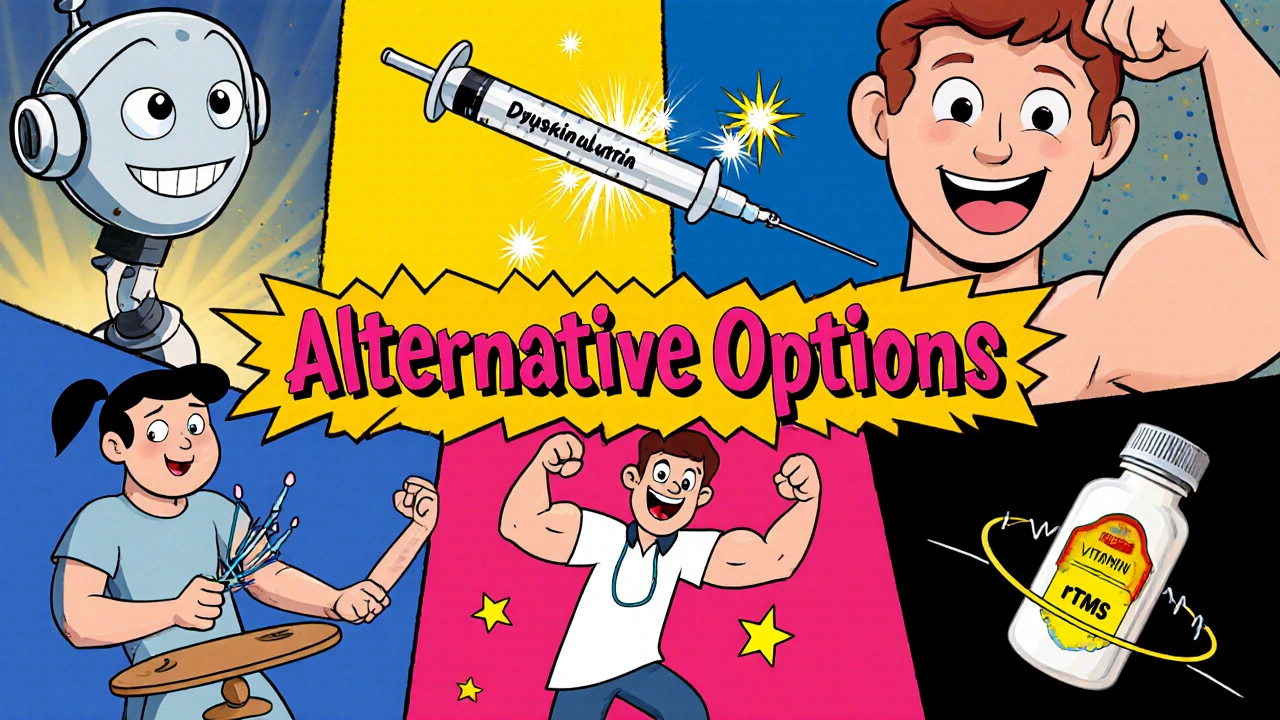
Complementary and Integrative Therapies
Acupuncture stimulates specific points to modulate the autonomic nervous system and reduce muscle hyperactivity. Small‑scale Chinese studies (2020, 2022) noted a 20% drop in facial dyskinesia scores after 10 sessions. While evidence is still emerging, patients report minimal adverse effects beyond mild soreness.
Transcranial Magnetic Stimulation (rTMS) delivers focused magnetic pulses to cortical regions, aiming to rebalance excitatory/inhibitory signals. A 2023 double‑blind trial demonstrated a 30% reduction in choreiform movements after 15 daily sessions over the motor cortex. Accessibility remains limited, and insurance coverage varies.
Nutritional supplements like vitamin D, omega‑3 fatty acids, and coenzyme Q10 have been investigated for neuroprotective effects. Observational data suggest higher vitamin D levels correlate with lower dyskinesia severity, but randomized trials are inconclusive. If you choose supplements, stick to clinically validated doses (e.g., 1,000 IU vitamin D daily) and discuss with your neurologist.
Medication Adjuncts Outside Traditional Dopaminergic Therapy
Levodopa remains the gold standard for Parkinson‑related dyskinesia, but dose‑adjustment strategies like “fractionated dosing” (smaller, more frequent doses) can mitigate peaks that trigger involuntary movements. Research from 2022 shows fractionated regimens cut dyskinesia intensity by 25% without worsening bradykinesia.
Other agents such as amantadine, a NMDA‑receptor antagonist, have proven anti‑dyskinetic properties. Extended‑release formulations (2021 FDA approval) offer a 30‑40% reduction in daily “on‑off” fluctuations. Side‑effects include insomnia and dry mouth, so start low and titrate slowly.
Comparison of Top Alternative Treatments
| Treatment | Evidence Level | Typical Benefit | Common Side Effects | Cost (US$) |
|---|---|---|---|---|
| Deep Brain Stimulation | High (RCTs, long‑term registries) | 30‑55% reduction in severity | Surgical infection, hardware issues | 50,000‑80,000 (initial) |
| Botulinum toxin injections | Moderate (controlled trials) | 30‑45% localized improvement | Temporary weakness, injection pain | 300‑600 per session |
| Physical Therapy & Exercise | Moderate (meta‑analysis) | 15‑22% functional gains | Muscle soreness | 40‑150 per month |
| Acupuncture | Low‑to‑moderate (small studies) | ~20% symptom drop | Minor bruising | 60‑120 per course |
| rTMS | Emerging (double‑blind trials) | ~30% reduction | Headache, scalp discomfort | 150‑300 per session |
| Supplementation (Vit D, Omega‑3) | Low (observational) | Potential modest benefit | Rare GI upset | 10‑30 per month |
Practical Checklist: Choosing the Right Alternative
- Assess severity and pattern: Focal (e.g., facial) vs. generalized dyskinesia influences whether you lean toward botulinum toxin or systemic approaches.
- Review medication regimen: Optimizing levodopa timing can lessen the need for invasive options.
- Evaluate comorbidities: Cardiac, psychiatric, or gait issues may contraindicate certain therapies.
- Consider access and cost: Insurance coverage for DBS or rTMS varies widely; PT and exercise are usually more affordable.
- Trial period: Start with low‑risk options (exercise, PT, supplements) and monitor changes for 6-8 weeks before escalating.
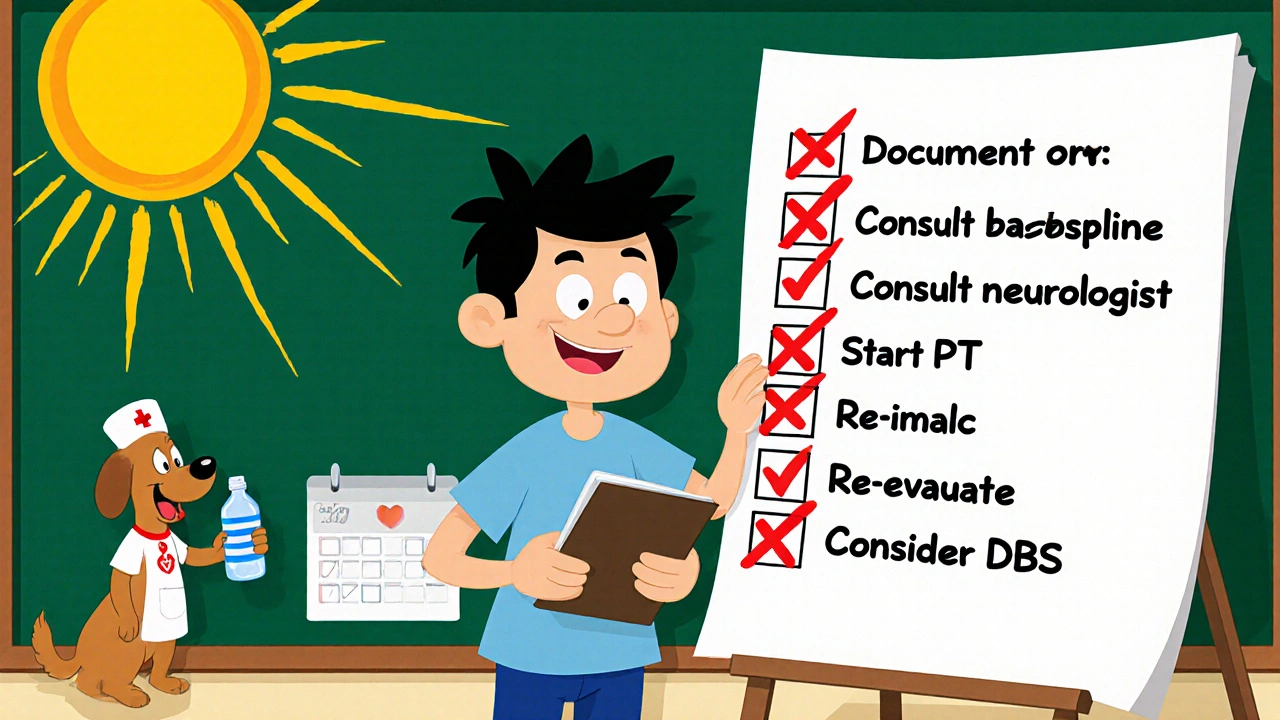
Potential Pitfalls and How to Avoid Them
Even promising alternatives can backfire if not applied thoughtfully.
- Over‑reliance on a single modality: Combine approaches (e.g., PT + medication adjustment) for synergistic effect.
- Skipping professional evaluation: Many treatments (botulinum toxin, DBS) require specialist assessment to target the right muscles or brain regions.
- Ignoring side‑effects: Even non‑pharmacologic therapies can cause fatigue, soreness, or temporary weakness. Track symptoms in a diary.
- Inconsistent adherence: Benefits wane if exercise or PT sessions are missed repeatedly.
- Unverified claims: Some online sources tout miracle cures without clinical backing. Stick to peer‑reviewed studies or reputable clinical guidelines.
Setting Up a Personal Dyskinesia Management Plan
Here’s a step‑by‑step roadmap you can adapt:
- Document baseline: Use a simple table to record daily dyskinesia episodes, triggers, and medication timing.
- Consult your neurologist: Discuss the possibility of adjusting levodopa or adding amantadine.
- Pick one low‑risk alternative: Start a structured PT or exercise regimen, aiming for three 45‑minute sessions per week.
- Schedule follow‑up: After 6 weeks, reassess symptom frequency. If improvement < 10%, consider adding a second modality (e.g., acupuncture).
- Evaluate higher‑intensity options: If symptoms remain disabling, discuss DBS eligibility or botulinum toxin injections with a movement‑disorder specialist.
- Maintain lifestyle habits: Adequate sleep, balanced diet, and stress‑reduction techniques (mindfulness, yoga) support overall motor control.
Mini‑FAQ
Can yoga help with dyskinesia?
Gentle yoga improves core strength and body awareness, which can reduce the intensity of involuntary movements. A 2022 pilot study showed a 12% drop in dyskinesia scores after an eight‑week yoga program. The key is low‑impact poses and steady breathing; avoid rapid transitions that might trigger tremor.
Is deep brain stimulation safe for older adults?
DBS is generally safe for patients up to their late 70s when health comorbidities are well managed. Complication rates rise slightly with age, mainly due to infection risk. A thorough pre‑operative cardiac and cognitive assessment helps ensure suitability.
How often should I get botulinum toxin injections?
Most clinicians repeat the injections every 3-4 months, aligned with the toxin’s duration of action. Slightly longer intervals can be tried if symptom control remains good, but beware of muscle weakening if doses accumulate.
Do supplements interfere with my Parkinson’s meds?
High doses of certain antioxidants may affect levodopa absorption, though evidence is limited. The safest route is to stick to recommended daily allowances (e.g., 1,000 IU vitamin D, 1 g omega‑3) and discuss any additions with your neurologist.
Can acupuncture replace medication?
Acupuncture works best as a complement, not a replacement. Most studies show modest improvements when used alongside standard meds. Stopping medication suddenly can cause severe rebound symptoms.
Next Steps If You’re Ready to Try an Alternative
1. **Write down your current regimen** - include dosage times, any side‑effects, and a week‑long dyskinesia diary.
2. **Identify a local specialist** - movement‑disorder neurologists, certified physical therapists, or licensed acupuncturists with experience in neuro‑rehab.
3. **Pick one new therapy** - start with the lowest‑risk, most accessible option (e.g., structured exercise).
4. **Set measurable goals** - aim for a 10‑15% reduction in peak dyskinesia episodes over the next month.
5. **Re‑evaluate** - after the trial period, discuss results with your doctor and decide whether to add or switch treatments.
Remember, dyskinesia management is rarely a one‑size‑fits‑all. Combining evidence‑based alternatives with careful medication tweaks gives you the best shot at smoother, more predictable movement.

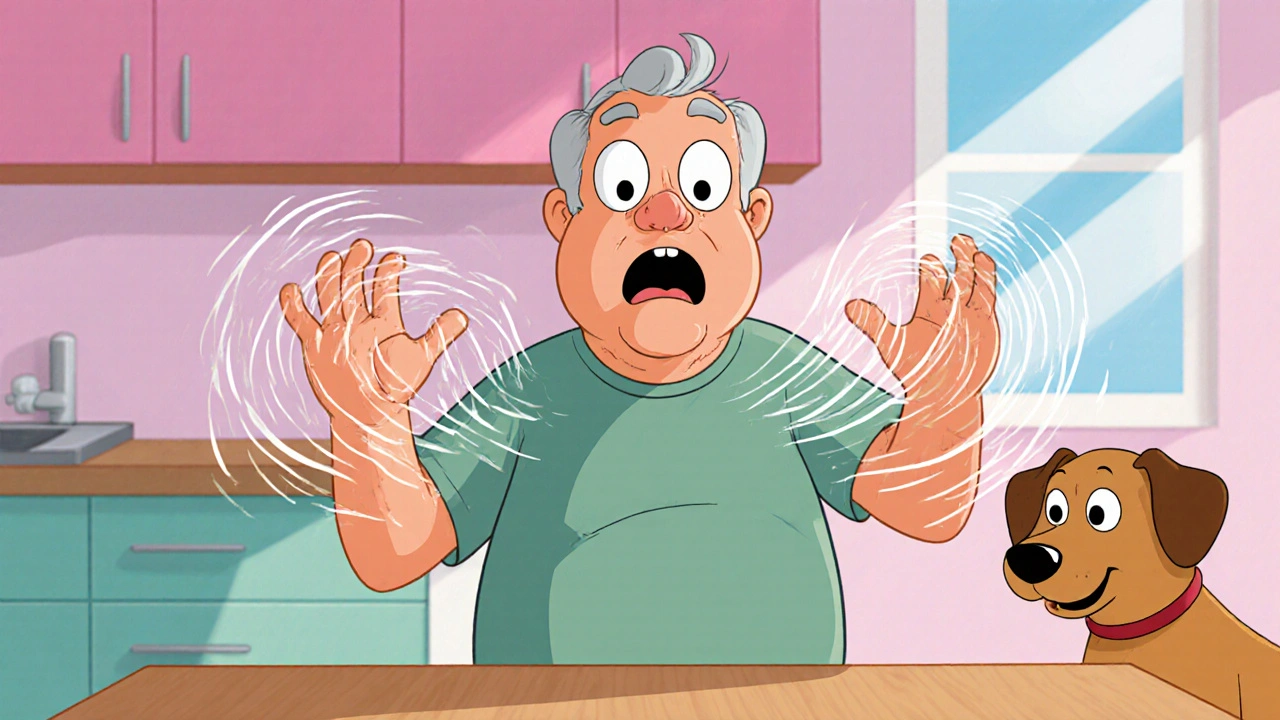

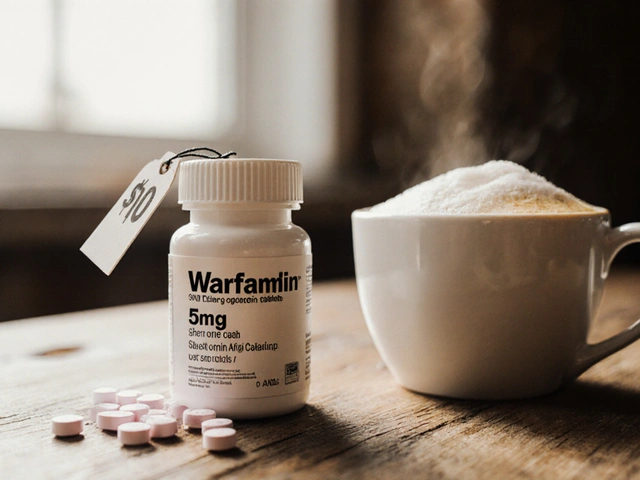
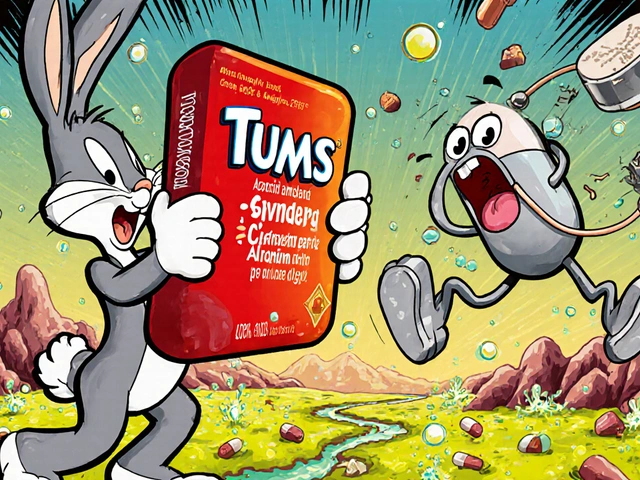
Ashok Kumar
October 21, 2025 AT 19:14Sounds like you’ve been through a lot, and yet the medical world keeps promising miracles while you keep guessing what works. I get it, it’s almost funny how “alternative” can feel like the last resort.
Jasmina Redzepovic
October 23, 2025 AT 22:40Let’s be clear: the United States leads the research frontier, and anyone ignoring the robust data on DBS and botulinum toxin is basically denying science. Your so‑called “alternatives” often lack the rigorous RCTs that our institutions demand, so prioritize evidence‑based options before chasing fringe hype.
Esther Olabisi
October 26, 2025 AT 02:05Wow, such a solid rundown! 🙃 I love how you laid out the pros and cons-makes it way easier to pick a starting point. If you’re feeling overwhelmed, just pick one low‑risk thing like a daily walk and watch the numbers shift. 😎
Erika Thonn
October 28, 2025 AT 04:31Life is a mosaic of movments and static that we can hardly unnderstand; the dancce of neurons echoes our inner philosphy. Yet, when we try to control the uncontroled, we often stumble into the same routh.
Harry Bhullar
October 30, 2025 AT 07:57When you dive into the dyskinesia toolbox, the first thing to realize is that no single approach will magically fix everything. Think of it as building a layered defense, where each layer addresses a different facet of motor control. The foundation is always an optimized medication regimen; fractional dosing of levodopa can smooth peaks that trigger involuntary bursts. On top of that, adding amantadine or extended‑release formulations can give you that extra 30‑40 % reduction in daily fluctuations. Next, consider a structured physical‑therapy program that hits three times a week, focusing on balance, strength, and proprioceptive drills. Consistency matters, because the neuroplastic benefits accrue only after weeks of repeated stimulus. If you have focal dyskinesia, botulinum toxin injections can temporarily silence the overactive muscles, giving you a 30‑45 % localized improvement for three to four months. For generalized symptoms, deep‑brain stimulation remains the gold standard, cutting severity by up to half once the device is tuned correctly. However, DBS is not without risk, so a thorough pre‑operative workup and realistic expectations are crucial. Complementary therapies such as acupuncture or tai chi can be valuable adjuncts; they don’t replace medication but can smooth the edges. Nutritional supplements like vitamin D or omega‑3 are low‑risk and may support overall neuronal health, though the evidence is still emerging. Transcranial magnetic stimulation is an exciting emerging option that targets cortical excitability, showing about a 30 % reduction in choreiform movements in recent trials. When you combine these modalities-medication tweaking, PT, and a targeted adjunct-synergy often exceeds the sum of parts. Keep a daily diary to track episode frequency, triggers, and any side‑effects, then review it with your neurologist every six weeks to fine‑tune the plan. Finally, remember that lifestyle factors such as stress management, adequate sleep, and a balanced diet are the invisible scaffolding that holds all the visible treatments together. In short, a multimodal, data‑driven approach gives you the best shot at smoother, more predictable movement.
Esther Olabisi
November 1, 2025 AT 11:22That was a beast of a post – love the thoroughness! 🙌 If you’re feeling a bit daunted, start small; even a 10‑minute daily stretch can make a difference over time. 🌟
Dana Yonce
November 3, 2025 AT 14:48Cool summary! I’m really curious about how the timing of meds plays into the whole thing 😊 seems like a simple tweak could have a big impact.
Lolita Gaela
November 5, 2025 AT 18:14From a mechanistic standpoint, augmenting dopaminergic tone with amantadine targets NMDA‑mediated excitotoxicity, thereby attenuating dyskinetic bursts. Moreover, the pharmacokinetic profile of the extended‑release formulation aligns better with circadian fluctuations, reducing “on‑off” phenomena. In practice, I recommend titrating up to 400 mg/day while monitoring for insomnia and dry mouth.
Giusto Madison
November 7, 2025 AT 21:40Alright, listen up – you want results, you gotta put in the work. Hit the gym three times a week, stick to your med schedule, and don’t skip the follow‑ups. Anything less is just wishful thinking.
erica fenty
November 10, 2025 AT 01:05Wow!!! Such a comprehensive guide-truly useful; many thanks!!!
Xavier Lusky
November 12, 2025 AT 04:31Everything you read about DBS and supplements is probably part of a larger agenda to push pharma profits. They don’t want you to know the real cure.
Ivan Laney
November 14, 2025 AT 07:57Look, as a proud American I’ve seen our researchers push boundaries that no other country can even dream of. The data coming out of our neurosurgical centers on deep‑brain stimulation is simply unmatched, and if you’re not leveraging those cutting‑edge protocols you’re basically leaving the best care on the table. Moreover, our regulatory framework guarantees that the devices you receive meet the highest safety standards, something that many overseas options can’t promise. So before you get swayed by anecdotal “alternative” hype, remember that the United States continues to set the gold standard for both clinical trials and patient outcomes in the realm of dyskinesia management.
Vivian Annastasia
November 16, 2025 AT 11:22Oh great, another “comprehensive” article that pretends to have all the answers while ignoring the messy reality most patients face. Nice work.
Nick M
November 18, 2025 AT 14:48Looks like a lot of hype for nothing.